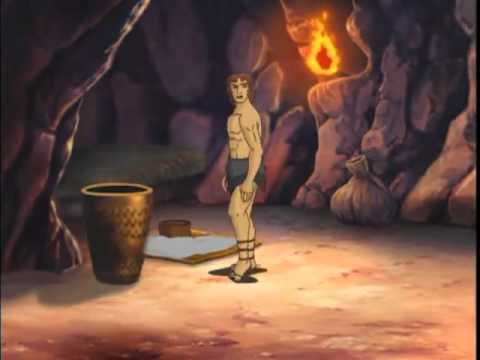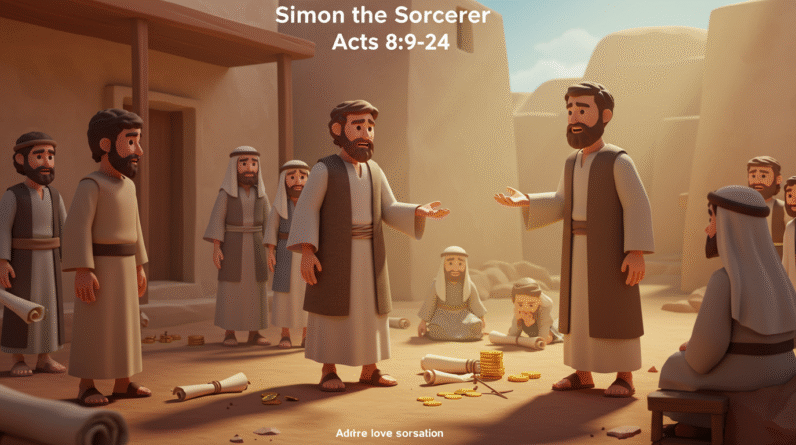In the article “Cain and Abel’s Biblical Characters,” you will be taken on a journey through the well-known biblical story of Cain and Abel. It begins with a summary of the story, introducing AEL, a shepherd, and Cain, a farmer, who are the sons of Adam and Eve. The article explores Cain’s jealousy towards Abel and his complaints about the work they do for God. It delves into their offerings to the Lord, with Cain’s lacking joy and gratitude. The consequences of Cain’s actions and his punishment to wander the Earth as a fugitive are discussed, as well as God’s protection for him. The article also highlights Adam’s devastation over the loss of both his sons. Overall, this article provides an engaging overview of the tale of Cain and Abel, inviting you to explore the complexities of this biblical narrative.

This image is property of i.ytimg.com.
Background
Introduction to Cain and Abel
The biblical story of Cain and Abel is a well-known tale from the book of Genesis. Cain and Abel were the sons of Adam and Eve, the first human beings according to the Bible. Cain was a farmer, while Abel was a shepherd. This story highlights the conflict between the two brothers and the consequences of jealousy and anger.
Relation to Adam and Eve
Cain and Abel’s story is closely related to the narrative of Adam and Eve. Adam and Eve were the first human beings created by God, and Cain and Abel were their children. The story takes place after Adam and Eve were expelled from the Garden of Eden due to their disobedience to God’s command. It showcases the struggles and challenges faced by their offspring in a fallen world.
The Story
Cain’s Jealousy towards Abel
From an early age, Cain harbored jealousy towards his brother Abel. Cain resented the favor that Abel received from their parents and from God. Abel was known for his genuine worship and his offerings to the Lord, which were pleasing to God. This jealousy festered within Cain’s heart, leading to disastrous consequences.
Sacrifices to the Lord
Both Cain and Abel offered sacrifices to the Lord, but the motivations behind their offerings were different. Abel’s offering was made with joy and gratitude, while Cain’s offering lacked sincerity and was not given with a grateful heart. God, being all-knowing, could see into their hearts and recognized the true nature of their sacrifices.
God’s Warning
God, in His mercy, warned Cain about the dangers of his jealous and resentful heart. He urged Cain to conquer the evil desires within himself. This warning was meant as an opportunity for Cain to turn away from his destructive path and seek redemption.
Cain’s Anger and Murder
However, instead of heeding God’s warning, Cain allowed his anger to consume him. He lured Abel to a field and, in a fit of rage and jealousy, murdered his own brother. This act of violence not only destroyed Abel’s life but also shattered the bond within their family.
Confrontation and Punishment
God confronted Cain about his evil deeds and held him accountable for the murder. Cain’s response was not one of remorse or repentance, but rather one of self-pity and fear, as he realized the severity of his punishment. God banished Cain from his land and cursed him to be a fugitive, wandering the Earth without a home.
Cain and Abel’s Fate
Cain as a Fugitive
As a result of his punishment, Cain became a fugitive, constantly on the run and never finding a place to call his own. The Bible does not provide details about the specifics of his wanderings, but it indicates that he was condemned to a life of restlessness and exile.
Divine Protection
Although Cain was a condemned fugitive, God showed him mercy by placing a protective mark on his forehead. This mark served as a sign to prevent others from harming him. Despite his sinful actions, God’s grace was still extended to Cain, providing him with a measure of divine protection.
Adam’s Grief
The loss of both sons, Abel through murder and Cain as a fugitive, brought immense grief to Adam. As a father, he was devastated by the consequences of their actions and the breakdown of their relationship. This tragedy weighed heavily on him and marked a turning point in the history of humanity.
Lessons and Themes
Jealousy and its Consequences
The story of Cain and Abel serves as a cautionary tale about the destructive power of jealousy and the devastating consequences it can have on individuals and relationships. Cain’s jealousy towards his brother led to the ultimate act of fratricide, causing irreparable damage to their family.
The Importance of Genuine Worship
The story emphasizes the importance of sincere and genuine worship. Abel’s offering was accepted by God because it was made with joy and gratitude. This highlights the significance of worshiping God with a pure heart and the blessings that come from a genuine relationship with Him.
The Power of God’s Warning
God’s warning to Cain demonstrates His grace and desire for reconciliation. The warning was an opportunity for Cain to recognize his destructive path and turn away from it. It shows that God desires repentance and offers the chance for redemption even in the face of sin.
The Severity of Cain’s Punishment
Cain’s punishment reflects the severity of his crime. Banished from his land and destined to wander as a fugitive, Cain faced a life without stability, peace, or a place to call his own. This serves as a reminder of the far-reaching consequences of our actions and the need to consider the gravity of our decisions.
The Impact of Sin on Relationships
The story of Cain and Abel demonstrates the destructive impact of sin on relationships. Cain’s jealousy and anger severed the bond between him and his brother, leading to tragedy. It serves as a reminder to guard against the destructive influence of sin in our interactions with others.
Symbolism and Interpretations
Cain and Abel as Representative Types
Cain and Abel can be seen as representative types of different aspects of human nature. Cain represents the sinful nature of humanity, filled with jealousy, anger, and the potential for violence. Abel, on the other hand, symbolizes righteousness, genuine worship, and a heart inclined towards God.
The Sign on Cain’s Forehead
The mark placed on Cain’s forehead is a symbol of God’s mercy and protection. It serves as a reminder of the consequences of his actions and acts as a warning to others not to harm him. The mark can be seen as a physical representation of God’s grace and a sign of His ultimate authority over life and death.
Cain’s Wanderings and Reflection
Cain’s life as a fugitive, wandering from place to place, can be interpreted as a time of reflection and repentance. As he traveled, he may have contemplated the magnitude of his actions and sought God’s forgiveness. It serves as a reminder that even in our darkest moments, there is always the opportunity for redemption and reconciliation.
Cain’s Significance in the Bible
Cain’s story holds significance in the Bible as it provides insights into the fallen nature of humanity and the consequences of sin. It serves as a reminder of the need for repentance, the power of God’s grace, and the ultimate significance of the sacrifice of Jesus Christ for the redemption of mankind.
Cultural and Historical Significance
Influence on Judeo-Christian Beliefs
The story of Cain and Abel has had a significant influence on Judeo-Christian beliefs and understanding of human nature. It serves as a foundational story that highlights the consequences of sin and the need for redemption. The story has been interpreted and taught throughout history as a lesson in morality and the consequences of destructive behavior.
Artistic Representations and Literature
The story of Cain and Abel has been a popular subject in art and literature. It has been depicted in various paintings, sculptures, and literature, often exploring themes of jealousy, murder, and fratricide. These artistic representations serve as a visual interpretation of the story and can evoke emotional responses and contemplation.
Ethical and Moral Interpretations
The story of Cain and Abel has been a source of ethical and moral interpretations throughout history. It raises questions about the nature of good and evil, the responsibility of individuals towards each other, and the consequences of one’s actions. It prompts discussions on topics such as forgiveness, justice, and the impact of sin on humanity.
Cain and Abel in Popular Culture
The story of Cain and Abel has permeated popular culture, with references and adaptations appearing in various forms of media. It is often used as a metaphor or inspiration for themes of sibling rivalry, jealousy, and crime. These cultural references serve to keep the story alive and relevant in contemporary conversations and storytelling.
Relevance and Applications Today
Lessons in Sibling Relationships
The story of Cain and Abel offers lessons on sibling relationships, highlighting the importance of love, respect, and healthy dynamics within families. It serves as a reminder to nurture positive sibling relationships and to address conflicts and emotions in a constructive and non-violent manner.
The Importance of Gratitude and Contentment
Cain’s lack of gratitude and contentment in his offering provides a lesson on the importance of appreciating what we have and finding joy in giving. It serves as a reminder to cultivate a grateful heart and to approach worship, work, and relationships with an attitude of gratitude.
Recognizing the Early Warning Signs of Sin
God’s warning to Cain highlights the importance of recognizing and addressing the early warning signs of sin. It reminds us to be aware of our emotions, thoughts, and desires and to take proactive steps to prevent destructive behavior before it escalates.
Addressing and Overcoming Jealousy
Jealousy is a common human emotion, and the story of Cain and Abel provides insights into the destructive power of jealousy. It prompts us to reflect on our own struggles with jealousy and to seek healthy ways to address and overcome this emotion in our lives.
Finding Redemption and Forgiveness
Despite his grave sin, Cain’s story ultimately shows that redemption and forgiveness are possible. The story reminds us that no matter how far we have fallen or how deep our guilt, God’s grace is available to all who seek it. It encourages us to turn to God in repentance and to find peace in His forgiveness.
Controversies and Debates
Cain’s Motivations and Character
The motivations and character of Cain have been the subject of much debate and scholarly interpretation. Some argue that his actions were driven solely by jealousy and anger, while others speculate on deeper psychological and theological implications. These debates contribute to a nuanced understanding of the story and its implications.
The Justice and Mercy of God
The punishment and mercy shown to Cain by God raise questions about divine justice and mercy. Some question whether Cain’s punishment was too severe or if the mark of protection was a form of mercy. These discussions explore the delicate balance between justice and mercy in divine dealings with humanity.
Interpreting God’s Warning and Punishment
Different interpretations exist regarding the purpose and implications of God’s warning to Cain and his subsequent punishment. Some see it as an opportunity for repentance, while others view it as a condemnation. Interpretations of the warning and punishment contribute to discussions on divine patience, justice, and the human response to God.
Theological and Philosophical Discussions
The story of Cain and Abel has sparked theological and philosophical discussions throughout history. These discussions explore themes such as the nature of sin, the origin of evil, the human condition, and the relationship between free will and divine sovereignty. These debates contribute to the ongoing exploration of complex theological and philosophical concepts.
Interactions with Other Biblical Characters
Relation to Adam and Eve
Cain and Abel’s story is closely related to their parents, Adam and Eve. Their actions and the consequences of their actions reflect and contribute to the narrative of Adam and Eve’s disobedience and their subsequent expulsion from the Garden of Eden. The story showcases the impact of their sin on future generations.
Influence on Future Generations
Despite their tragic end, Cain and Abel had a significant influence on future generations. Their story serves as a cautionary tale and a lesson about the destructive power of sin. The consequences of their actions reverberated throughout history, shaping the understanding of humanity’s fallen nature and the need for redemption.
Relevance in the Messianic Lineage
Cain and Abel’s story plays a small but significant role in the lineage leading to the Messiah. Although Cain’s line is not traced directly to Jesus Christ, his story highlights the contrast between righteousness and sin, ultimately pointing towards the need for a Savior.
Comparisons with Other Biblical Siblings
Cain and Abel’s story provides insights into the dynamics of sibling relationships in the Bible. Their conflict and its tragic outcome can be compared and contrasted with other biblical siblings, such as Jacob and Esau or Joseph and his brothers. These comparisons contribute to a broader understanding of sibling dynamics and their impact on biblical narratives.
Conclusion
Legacy of Cain and Abel
The story of Cain and Abel has left a lasting legacy in religious and cultural contexts. It continues to be studied, interpreted, and taught as a cautionary tale about the consequences of sin and the importance of genuine worship and healthy relationships. The story serves as a reminder of the fallen nature of humanity and the need for redemption.
Relevance of their Story
Cain and Abel’s story remains relevant today, as it addresses timeless themes such as jealousy, sibling relationships, the consequences of sin, and the search for forgiveness and redemption. The story resonates with readers across cultures and generations, offering valuable lessons and insights into the complexities of the human condition.
Continued Exploration and Study
Given the rich symbolism, varied interpretations, and ongoing discussions surrounding Cain and Abel’s story, it will continue to be a subject of exploration and study. Scholars, theologians, and individuals will continue to delve into the deeper meanings and implications of the story, seeking a deeper understanding of its message and relevance in today’s world.







